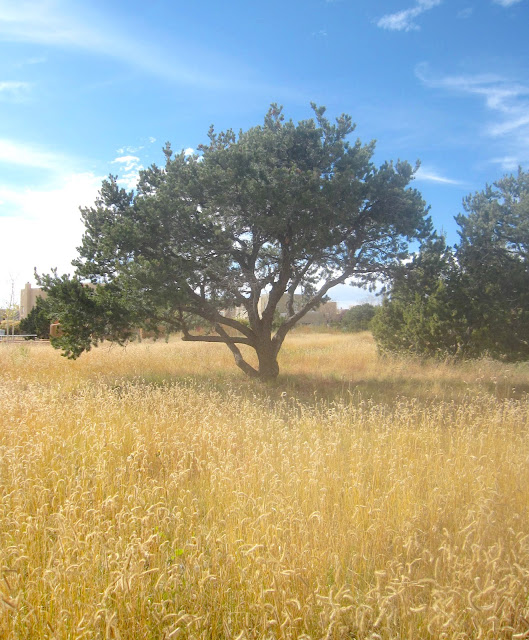The Natural Landscape
I lived in an HOA neighborhood for 13 years in Connecticut and have lived in one now for almost 5 years here in Santa Fe. Homeowner Associations have benefits for the kind of cohesive, suburban community I want to live in, but of course there are issues with rules compliance.
But I don't want to talk about bylaw enforcement today, I want to talk a bit about the design concept itself.
The two neighborhoods I have lived in were both conceived as communities in natural settings. They were beautifully designed to have open areas, walking paths, trees and meadows. It was a thing in the 1980s and 1990s for new developments, a reaction against earlier scraped subdivisions that were cookie cutter and sterile.
These new communities touted the beauty of the natural surroundings. They reserved tracts of land that were to remain untouched. Natural. Undeveloped. Open areas owned by all for the use of all, under an HOA commons agreement.
 |
| From the developer's site -- what they thought our open areas would look like if left untended. They don't. |
These HOA designs deliberately left separate pockets of natural land dotted among the homes and woven through the neighborhood for a lovely look. They did not scrape the land bare and build, they carefully let areas with vegetation remain among building lots.
Twenty years on, that design has proved to be a problem. There is no way to keep untouched plots of land from reverting to wild chaos. In the northeast untended land became a weed field on its way to becoming forest. In the southwest it becomes tumbleweeds. These "natural" pockets of land are not stable systems, they are not self-sustaining, they are not static.
Plants die, trash gets wind driven into the weeds, paths become overgrown, unwanted invasive growth dominates. It all encroaches on small homeowner yards right next to the wild bits.
In the southwest the fire hazard of uncleared common land weaves around all the homes.
 |
| Chamisas overgrow the common area paths behind houses and need constant aggressive trimming. |
These developments left maintenance of common areas unfunded. Both associations I have lived in collect fees for common structure maintenance and for street landscapes and cul de sac grounds to be maintained, but the wild areas -- since they were "natural" -- would take care of themselves. That was the assumption.
In this association we have 37 acres of unmanaged land, divided up into parcels all over, some with walking paths. I'm on the grounds committee for the association, and we get complaints about overgrowth, dead stuff, trash and fire hazards. There are $0 funds in the budget for maintenance of any open area, and the excruciatingly detailed Declaration for the HOA has no reference at all to responsibilities for maintaining all the natural areas adjacent to almost every home.
 |
| Invasive kochia weeds take over grasses in open meadow areas -- they turn into dried tumbleweeds. |
Every pebble in a lot owner's yard is regulated and defined in the Declaration and bylaws, but the open areas were assumed to need no reference, no definition, no oversight ever. Yikes.
It's a fundamental misunderstanding of what natural landscapes are. Both associations I have lived in made assumptions that a strip of untouched land would take care of itself and remain tidy and beautiful, just not manicured like yards or sidewalks.
It was a common perception 20 and 30 years ago when this type of natural looking development was being built. And it is still a concept that seems so, well . . . intuitive. It is nature, after all. It needs no tending, it just is.
Well, that doesn't work.
Comments